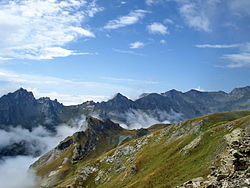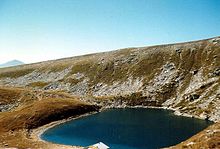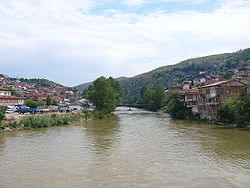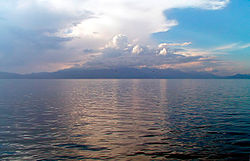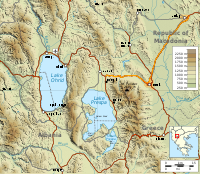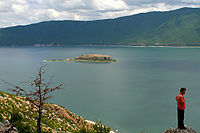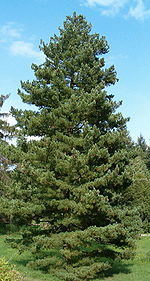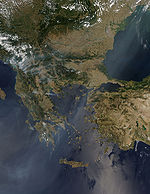- Geography of the Republic of Macedonia
-
Geography of Republic of Macedonia 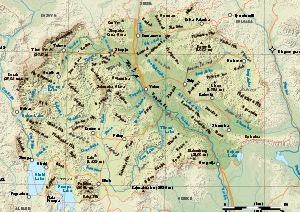
Continent Europe Region Balkan Peninsula Coordinates 41°50′N 22°00′E / 41.833°N 22°E Area Ranked 148
25,713 km2 (9,928 sq mi)
96.67% land
3.33% waterBorders 748 km Highest point Mount Korab, 2,764 m Lowest point Vardar River (near Gevgelija), 50 m Longest river Vardar, 388 km Largest lake Lake Ohrid 348 km2 The Republic of Macedonia is a country situated in southeastern Europe with geographic coordinates 41°50′N 22°00′E / 41.833°N 22°E, bordering Kosovo and Serbia to the north, Bulgaria to the east, Greece to the south and Albania to the west. The country is part of the wider region of Macedonia and makes up most of Vardar Macedonia. The country is a major transportation corridor from Western and Central Europe to Southern Europe and the Aegean Sea. Macedonia is a landlocked country but has three major natural lakes: Lake Ohrid, Lake Prespa and Lake Dojran. It has a water area of 857 km2, while its land area is 24,856 km2.
Phytogeographically, Macedonia belongs to the Illyrian province of the Circumboreal Region within the Boreal Kingdom. According to the WWF and Digital Map of European Ecological Regions by the European Environment Agency, Macedonia's territory can be subdivided into four ecoregions: the Pindus Mountains mixed forests, Balkan mixed forests, Rhodopes mixed forests and Aegean sclerophyllous and mixed forests.
Contents
Climate
Macedonia has unique climate explained by its location and topography. The climate of the plains is extraordinary - Mediterranean climate combined with the influence of the Black Sea.[1] The country also holds continental characteristics, which are accentuated by the mountains in the south which prevent hot air from the south to move to the north. Conversely, the Šar Mountains, which are located in the northwestern part, block cold northern winds. In whole, the northern and western parts of the country are relatively close to Continental climate and the southern and eastern to Mediterranean climate.[2]
Macedonia has four seasons weather, but the lengths of the seasons varies based on geography. The spring is often very short.[2] Summers are subtropical so it is not uncommon to see temperatures of above 40 °C (104 °F) during this season, especially in the plains along the valley of the Vardar river.[1] Winters, although moderate, can sometimes be quite cold. Snowfalls during winter are common and sometimes heavy. The average annual temperature of the air is 11.5 °C (53 °F), but the plains experience higher temperatures, 15 °C (59 °F).[2] The warmest month is July, which has an average temperature of 22.2 °C (72 °F) and the coldest is January, with a temperature of 0.3 °C (33 °F). The maximum and minimum temperatures recorded in Macedonia to date are 44.5 °C (112 °F) and −31.5 °C (−25 °F), respectively.[3]
The rainfall is abundant in the western and eastern parts of the country, but the temperature decreases significantly in the Vardar region.[2] This region sees warmer winters through the Vardarec wind. This wind comes up from the mouth of the Vardar river and brings warm air.[1] Skopje, considered a low-lying city, has an average of 64 rainy days per year. The month of October is the wettest with 61 mm; the driest is August with 28 mm. Rains are most common in the spring and fall.[4]
Climate Facts:[5][6][7] Place Region Latitude Longitude Altitude (m) Rainfall (mm) Temperature
(°C)Skopje North of the valley of the Vardar 42° 00’ 21° 26’ 245 940 13,5 Kočani Eastern Macedonia 41° 50’ 22° 00’ 400 538 12,9 Lake Ohrid Southwest Macedonia 41° 03’ 20° 42’ 693 759 11,4 Climatic data for Skopje :[8] Month Jan Feb Mar Apr May Jun Jul Aug Sep Oct Nov Dec Maximal temperature (°C) 5 10 13 18 23 28 31 30 26 20 10 7 Minimum temperature (°C) -5 2 5 7 12 16 18 18 15 11 6 -2 Rainfall (average height in mm) 100 103 113 175 201 123 132 102 109 127 124 141 Physical Geography
Boundaries
The country has some 748 km of boundaries, shared with Kosovo (159 km or 99 mi) to the northwest, Serbia (62 km or 39 mi) to the North, Bulgaria (148 km) to the east, Greece (228 km) to the south, and Albania (151 km) to the west.
The north border with Serbia and Kosovo is 221 kilometers in length. The border was made after World War II, between SR Macedonia and SR Serbia.[9] But in 2008 when Kosovo self-declared independence the border with it was remarked again. Rather more than half of the boundary separates Macedonia from Kosovo. From the tripoint with Albania, the boundary trends north-eastwards along the watershed of Šar Mountain. It describes a curve to the south across the River Lepenec and then turns to north-east to traverse Mount Crna before taking a course slightly to the north of east across the landscape features to the tripoint with Bulgaria.
The east border with Bulgaria has length of approximately 148 km. The settled boundary from Yugoslavia and the People's Republic of Bulgaria was accepted after the independence in 1992.[9] The boundary starts from the tripoint with Greece, the boundary runs north, crossing the River of Strumica and then rising to the watershed which it follows northwards and then north-westwards to the tripoint with Serbia.
The south border that splits Macedonia from Greece is 228 km long and it is the longest Macedonian border. The border was marked with the Treaty of Bucharest on 10 August 1913.[9] The border starts from the tripoint with Albania, in Lake Prespa, the boundary runs in a straight line eastwards across the lake and then continues in the north of east trend across the relief to the Voras Oros, where it turns north-eastwards. It traverses the watershed of the Voras Oros and then continues eastwards along the watershed before dropping to the valley of Vardar river. The boundary continues eastwards and then turns north across the Dojran lake, before, on the latitude of Valandovo, turning east to the tripoint with Bulgaria on Mount Tumba.
The boundary with Albania that is long 151 km was marked first in 1926 and then remarked with the Treaty of Paris in 1947.[9] The boundary starts from the tripoint with Kosovo and it follows a watershed before crossing, and for a short distance, following the Black Drin river and continuing along a crest line to Ohrid Lake. It crosses the lake, leaving approximately one-third in Albania, traverses a high ridge and "meets" the tripoint with Greece in Lake Prespa.
Topography
Main article: Mountains of the Republic of MacedoniaMacedonia is a landlocked country that is geographically clearly defined by a central valley formed by the Vardar river and framed along its borders by mountain ranges. The terrain is mostly rugged, located between the Šar Mountains and Osogovo, which frame the valley of the Vardar river. Three large lakes — Lake Ohrid, Lake Prespa and Dojran Lake — lie on the southern borders, bisected by the frontiers with Albania and Greece. Ohrid is considered to be one of the oldest lakes and biotopes in the world.[10] The region is seismically active and has been the site of destructive earthquakes in the past, most recently in 1963 when Skopje was heavily damaged by a major earthquake, killing over 1,000.
Macedonia also has scenic mountains. They belong to two different mountain ranges: the first is the Šar Mountains[11][12] that continues to the West Vardar/Pelagonia group of mountains (Baba Mountain, Nidže, Kozuf and Jakupica), also known as the Dinaric range. The second range is the Osogovo–Belasica mountain chain, also known as the Rhodope range. The mountains belonging to the Šar Mountains and the West Vardar/Pelagonia range are younger and higher than the older mountains that are part of the Osogovo-Belasica mountain group. The ten highest mountains in Macedonia are:
Rank Name Height (m) Height (ft) Rank Name Height (m) Height (ft) 1 Mount Korab 2,764 9,396 7 Galičica 2,288 7,507 2 Šar Mountains 2,747 9,012 8 Stogovo 2,273 7,457 3 Baba Mountain 2,601 8,533 9 Jablanica 2,257 7,405 4 Jakupica 2,540 8,333 10 Osogovo 2,251 7,383 5 Nidže 2,521 8,271 11 Mount Bistra 2,163 7,096 6 Dešat 2,373 7,785 12 Plačkovica 1,754 5,754 Hydrography
In the Republic of Macedonia there are 1,100 larger sources of water. The rivers flow into three different basins: the Aegean, the Adriatic and that Black Sea basin.[13]
The Aegean basin is the largest. It covers 87% of the territory of the Republic, which is 22,075 km. sq. Vardar, the largest river in this basin, drains 80% of the territory or 20,459 km. sq. Its valley plays an important part in the economy and the communication system of the country. The project named The Vardar Valley is considered to be crucial for the strategic development of the country.
The river Black Drim) forms the Adriatic basin, which covers an area of about 3,320 km. sq., i. e. 13% of the territory. It issues from Lakes Prespa and Ohrid.
The Black Sea basin is the smallest with only 37 km. sq. It covers the northern side of Mount Skopska Crna Gora. Here is the source of the river Binačka Morava which joins the South Morava and later the Danube, which eventually flows into the Black Sea.
Despite being a landlocked country, Macedonia has three large lakes (Ohrid, Prespa, and Dojran), three artificial lakes and roughly 50 ponds.
There are nine spa resorts in Macedonia: Banište, Banja Bansko, Istibanja, Katlanovo, Kežovica, Kosovrasti, Banja Kočani, Kumanovski Banji and Negorci.
River Vardar
The Vardar is the longest and most important river in the Republic of Macedonia. It is 388 km (241 mi) long, and drains an area of around 25,000 km2 (9,700 sq mi).
The river rises at Vrutok, a few kilometers north of Gostivar in the Republic of Macedonia. It passes through Gostivar, Skopje and into Veles, crosses the Greek border near Gevgelija, Polykastro and Axioupoli, before emptying into the Aegean Sea in Central Macedonia west of Thessaloniki in northern Greece.
The Vardar basin includes two-thirds of the territory of the Republic of Macedonia. For that the area is called "Vardar Macedonia" after the river, to distinguish it from "Aegean Macedonia" (in Greece) and "Pirin Macedonia" (in Bulgaria).
The valley comprises fertile lands in Polog, Gevgelija and other parts. The river is surrounded by mountains elsewhere. The M1 / E75, connecting with Greek National Road 1, runs through the valley along the river's entire length to near Skopje.
The river is depicted on the coat of arms of Skopje, which in turn is incorporated in the city's flag.[14]
Lake Ohrid
Lake Ohrid (Macedonian: Охридско Езеро, Ohridsko Ezero) straddles the mountainous border between the southwestern Republic of Macedonia and eastern Albania. Lake Ohrid is the deepest lake of the Balkans, with a maximum depth of 288 m (940 ft) and a mean depth of 155 m (508 ft). It covers an area of 358 km2 (138 sq mi), containing an estimated 55.4 km³ of water. It is 30.4 km long by 14.8 km wide at its maximum extent with a shoreline length of 87.53 km, shared between the Republic of Macedonia (56.02 km) and Albania (31.51 km). The lake drains an area of around 2600 km² and is fed primarily by underground springs on the eastern shore (about 50% of total inflow), with roughly 25% shares from rivers and direct precipitation. Over 20% of the lake's water comes from nearby Lake Prespa, about 10 km (6.2 mi) to the southeast and at 150 m higher altitude than Lake Ohrid.
While Lake Ohrid is special as such, by far the most spectacular quality is its impressive endemism. Similar to Lake Baikal or Lake Tanganyika, Lake Ohrid harbors endemic species covering the whole food-chain, from phytoplankton and sestile algae (20 species; e.g., Cyclotella fottii), over plant species (2 species; e.g., Chara ohridana), zooplankton (5 species; e.g., Cyclops ochridanus), cyprinid fish (8 species; e.g., Pachychilon pictus), to predatory fish (2 trout species; Ohrid trout Salmo letnica and "Belvica" Acantholingua ohridana) and finally its diverse endemic bottom fauna (176 species; e.g. Ochridagammarus solidus), with particularly large endemism among crustaceans, molluscs, sponges and planarians.
There are three cities on the lake's shores: Ohrid and Struga on the Macedonian side; Pogradec in Albania. There are also several fishing villages, although tourism is now a more significant part of their income. The catchment area of the lake has a population of around 170,000 people, with 131,000 people living directly at the lake shore (43,000 in Albania and 88,000 in the Republic of Macedonia).
Lake Prespa
The Great Prespa Lake (Macedonian: Преспанско Езеро, Prespansko Ezero) is divided between Albania, Greece and the Republic of Macedonia. The biggest island in the Great Prespa Lake, on the Republic of Macedonia's side, is called Golem Grad ("Large Town"), or Snake Island (Zmiski Ostrov). The other island Mal Grad (Small Town, in Albania) is the site of a ruined 14th century monastery dedicated to St. Peter. Today, both islands are uninhabited.
Because Great Prespa Lake sits about 150m above Lake Ohrid, which lies only about 10 km (6.2 mi) to the west, its waters run through underground channels in the karst and emerge from springs which feed streams running into Lake Ohrid.
Dojran Lake
Dojran Lake, located in southeastern Macedonia, is the smallest of the three major lakes with an area of 42.7 km². It is shared between the Republic of Macedonia (27.1 km²) and Greece (15.6 km²).[15] The town of Dojran is situated on the west coast of tha lake, while the Greek village of Mouries lies to the east. To the north is the mountain Belasica and to the south is the Greek town of Doirani. The lake is round in shape, has a maximum depth of 10 metres, has a north-to-south length of 8.9 km, and is 7.1 km at its widest.[16]
Flora and fauna
The flora of Macedonia is represented with around 210 families, 920 genera, and around 3,700 plant species. The most abundant group are the flowering plants with around 3,200 species, which is followed by mosses (350 species) and ferns (42).
Phytogeographically, Macedonia belongs to the Illyrian province of the Circumboreal Region within the Boreal Kingdom. According to the WWF and Digital Map of European Ecological Regions by the European Environment Agency, the territory of the Republic can be subdivided into four ecoregions: the Pindus Mountains mixed forests, Balkan mixed forests, Rhodopes mixed forests and Aegean sclerophyllous and mixed forests.
The fauna of Macedonian forests is abundant and includes bears, wild boars, wolves, foxes, squirrels, chamois and deer. The lynx is found, although very rarely, in the mountains of western Macedonia, while deer can be found in the region of Demir Kapija. Forest birds include the blackcap, the grouse, the black grouse, the imperial eagle and the forest owl.
The three artificial lakes of the country represent a separate fauna zone, an indication of long-lasting territorial and temporal isolation. The fauna of Lake Ohrid is a relict of an earlier era and the lake is widely known for its letnica trout, lake whitefish, gudgeon, roach, podust, and pior, as well as for certain species of snails of a genus older than 30 million years; similar species can only be found in Lake Baikal. Lake Ohrid is also noted in zoology texts for the European eel and its baffling reproductive cycle: it comes to Lake Ohrid from the distant Sargasso Sea, thousands of kilometres away, and lurks in the depths of the lake for 10 years. When sexually mature, the eel is driven by unexplained instincts in the autumn to set off back to its point of birth. There it spawns and dies, leaving its offspring to seek out Lake Ohrid to begin the cycle anew.[17]
Minerals and ores
Macedonia is rich in chromium, lead, zinc, manganese, tungsten, nickel, low-grade iron ore, asbestos, sulfur, timber. Also it is one of possibly two places in the world where the Lorandite mineral is found.
Land use
- 24% of the country's territory is arable land.
- 2% of permanent crops
- 25% of permanent pastures
- 39% of forests and woodland
- 10% - other. (1993 est.).
According to 1993 estimates, there are 830 km2 of irrigated land.
Degradation and protection of the environment
In July 2007, fires were particularly visible in Greece, Albania and Macedonia.
The environment is preserved in areas impractical and sparsely populated. In addition, the country has three major national parks, created under the Yugoslav regime of 1948-1958. The parks of Pelister, Mavrovo and Galičica cover an area of 108,250 acres (438.1 km2) and allow for the protection of natural areas by their exceptional geological setting, their fauna and flora. The ornithological reserve Ezerani, north of Lake Prespa, is 2000 hectares big and is home to sixty animals protected by the Bern Convention.
However, if it is protected where man has little access, nature is threatened the outskirts of towns and villages. Indeed, in order to make Macedonia, formerly rural and poor, a modern and prosperous country, the Yugoslav communist regime established many factories, often highly polluting. These factories, located mainly in the regions of Veles and Skopje are still functioning. The emissions of waste pollutants have decreased after 1991, when independence is, because many companies have gone bankrupt or have reduced their activity after the transition to a market economy.
The other danger of degradation of nature lies in waste. Indeed, only the city of Skopje has a processing center for household waste in the rest of the country, so they are left in open dumps. The lack of resources and political will behind these fatal neglect for the environment.
Macedonia is also experiencing serious problems in water management. The country, which has a hot and arid summer climate, however should be able to secure its water through its dams and its sources. In summer, water restrictions are common.[18] The summer period is also marked by the devastation of forests by fire.[19] In 2008, six million trees were planted in Macedonia to regenerate damaged forests.[20]
The environmental degradation nevertheless mobilizes local groups and Macedonia is a signatory to international treaties like the Kyoto Protocol.[21]
The three national parks :
Human Geography
Differences in population and urbanization
The Republic of Macedonia is a rural country towns, with only 45% of the population concentrated in the towns and cities. Skopje, with more than 500,000 inhabitants, is by far the largest city in the country. His region, one of the few plains of the country, includes several other important cities, like Tetovo and Gostivar. Bitola, Prilep and other significant cities, are located in the plain of Pelagonia the south, which is the second home stand. The rest of the population is concentrated in the valley of the Vardar and the few other basins and plains of the country.
Urbanization, which is developing very fast since the communist era of Yugoslavia, has led to uncontrolled and illegal constructions. The outskirts of Skopje account and neighborhoods that strongly resemble slums. Other cities have not grown as spectacular as the capital, which has won more than 300,000 inhabitants between 1948 and 1981. Bitola, Prilep and Kumanovo, the three other major cities, did not exceed 30,000 inhabitants in 1948 and barely reached 100,000 people since. Kumanovo, which is the second city of Macedonia, had only 105,000 inhabitants in 2002, which is very big difference comparing it with the population of the capital Skopje - 506,000 inhabitants.
Population of the most populous Macedonian municipalities[22]

Ethnic distribution
 The municipalities of Macedonia according to the ethnic majority (in yellow, the Macedonians, in orange the Albanians, in green Turks, in blue municipalities with mixed ethnic groups)
The municipalities of Macedonia according to the ethnic majority (in yellow, the Macedonians, in orange the Albanians, in green Turks, in blue municipalities with mixed ethnic groups)
The Macedonians are the largest ethnic group in the country, accounting for 64.2% of the total population, according to the 2002 census. They speak the Macedonian language and most are Orthodox Christians. Ethnic Albanians are the country's largest minority, making up one-quarter of the total population. They live mainly in the west and northwest. The Turks, who comprise nearly 4% of the population, are mostly scattered, though they form a majority in two municipalities (Plasnica and Centar Župa). The Romani make up 2.7% of the population and are also concentrated throughout Macedonia, while the Serbs, who form just under 2% of the total population, live mostly in the north of the country.[21]
Administrative divisions
Main articles: Statistical regions of the Republic of Macedonia and Municipalities of the Republic of MacedoniaMacedonia is divided into eight statistical regions: Skopje, Pelagonia, Polog, Vardar, Eastern, Southeastern, Northeastern and Southwestern.[23]
The country is further divided into 84 municipalities. Until 1996, there were 123 municipalities, but several laws aimed at increasing the rights of minorities decreased the number of municipalities and modified their overall role. Skopje, the nation's capital, is itself divided into ten municipalities.[24]
Economic geography
Macedonia, like most countries in Eastern Europe, has a developing economy.[25] Under Yugoslavia, Macedonia saw the establishment of many factories and the significant modernisation of the country, especially after the devastating Skopje earthquake of 1963. Since independence in 1991, Macedonia has suffered the transition to market economy.[26] Greece, which believes that the republic is monopolising the cultural and historical heritage of Macedonia, imposed an embargo in 1993 and has prevented the country's accession to organisations like the European Union and NATO.[27]
In 1995, the Greek embargo was lifted and Macedonia was finally able to access the IMF and World Bank. The country still suffers, however, from its isolation and lack of foreign investment. In 2007, the unemployment rate was estimated at 32% and the black market provided about 20% of the Gross Domestic Product.[21]
Characteristics and advantages
The Republic of Macedonia's geographical positioning provides it with many advantages. One advantage is the geographical position of the country. It is the center of the Balkans, between Belgrade and Athens, Tirana and Sofia, between the Adriatic and Black Sea. The Vardar valley forms a natural corridor, which connects Greece to the rest of Europe. This corridor is crossed by the highway E75, which crosses in Europe and connects Scandinavia with Attica. This highway has also been renovated in Macedonia with the European Agency for Reconstruction, and the communication channels that connect the Adriatic to the Black Sea, called the Corridor VIII, were also upgraded and maintained through international assistance including the Italian one.[28]
Macedonia is also rich with minerals. The country in fact has substantial deposits of chromium and other nonferrous metals like copper, zinc, manganese and nickel.[21] The country also has gypsum mines,[21] marble and granite, located in Pelagonia. Lignite, provides 80% of the Macedonian electricity. In addition to mines and quarries, the country has large cement plants and large complexes of metal, created by the communist regime.
Agriculture is encouraged by the significant water resources, managed by dams and canals. The presence of hot springs of volcanic origin can heat the greenhouses in winter, particularly in the Strumica region, whose products include tomatoes and cucumbers in the month of February. Different climates provide opportunities for various productions in the geographical area, so the vine and tobacco are operated in the south, the rice in the region of Kočani which is largely irrigated, and the wood industry is concentrated around Štip.[29] Agriculture contributes a significant share of exports, especially with the wine and tobacco. The low cost of labor also helps the textile industry.
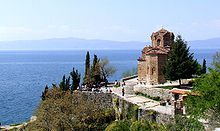 Church of St. John at Kaneo with a view of the Ohrid Lake, the most popular destination for tourists in Macedonia
Church of St. John at Kaneo with a view of the Ohrid Lake, the most popular destination for tourists in Macedonia
The Republic of Macedonia receives about 700,000 tourists annually[30] and experiences a constant increase of visitors. The number of domestic tourists in the period from January to March 2008 compared to the same period of the previous year, increased 23.5%. While the number of foreign tourists in March 2008 compared to March 2007 increased 44.7%.[31] In 2007, Lake Ohrid had received about 250,000 domestic and foreign tourists.[32] In February 2009, nearly 28,000 tourists, or 3.2% more than the same month last year, visited Macedonia. There was also an 8% increase in the number of foreign visitors to the country.[33] The summer of 2009 was the city of Dojran's best tourist season with 135,000 overnight visitors, an increase of 12.5% compared to the previous year.[34]
The tourist capital of Macedonia, Ohrid,[35] has been listed as an UNESCO World Heritage Site since 1979.[36]
See also
- Republic of Macedonia
- Atlas of the Republic of Macedonia
- Tourism in Macedonia
- Economy of the Republic of Macedonia
References and notes
- ^ a b c Georges Castellan, op. cit., p. 13
- ^ a b c d Dominique Auzias et Jean-Paul Labourdette, op. cit., p. 25
- ^ "Macedonian ambassy in the United-Kingdom - Country and people". Macedonianembassy.org.uk. http://www.macedonianembassy.org.uk/country_profile.html. Retrieved 23 August 2010.
- ^ "Weather Centre - Skopje". BBC. http://www.bbc.co.uk/weather/world/city_guides/results.shtml?tt=TT004680. Retrieved 23 August 2010.
- ^ Град Скопје. "Official web-site of Skopje". Skopje.gov.mk. http://www.skopje.gov.mk/EN/DesktopDefault.aspx?tabindex=0&tabid=33. Retrieved 23 August 2010.
- ^ "Official web-site of Kočani". Kocani.gov.mk. http://www.kocani.gov.mk/English/uvod_en.htm. Retrieved 23 August 2010.
- ^ "Web-site about the region of Ohrid". Ohrid.org.mk. http://www.ohrid.org.mk/eng/ohez/oeos.htm. Retrieved 23 August 2010.
- ^ "Climatic data for Skopje". Meteolafleche.com. http://www.meteolafleche.com/Climatologie/Europe/climatskopje.html. Retrieved 23 August 2010.
- ^ a b c d International boundaries: a ... - Google Books. Books.google.com. 10 February 1947. http://books.google.com/books?id=E7-menNPxREC&pg=RA1-PA510&lpg=RA1-PA510&dq=boundaries+of+the+republic+of+Macedonia&source=bl&ots=G9aG87kT-k&sig=sdrkHtVt9vxog0RC7B9rDOcqJDc&hl=en&ei=2j7GSrruK8j8_AbrmdyWCA&sa=X&oi=book_result&ct=result&resnum=1#v=onepage&q=boundaries%20of%20the%20republic%20of%20Macedonia&f=false. Retrieved 23 August 2010.
- ^ "Macedonian Ministry of Environment". Web.archive.org. Archived from the original on 19 January 2008. http://web.archive.org/web/20080119010740/http://www.moe.gov.mk/soer2/ohrid_a.htm. Retrieved 23 August 2010.
- ^ Encyclopædia Britannica. "Britannica's article about Sar Mountains". Britannica.com. http://www.britannica.com/EBchecked/topic/523838/Sar-Mountains. Retrieved 23 August 2010.
- ^ "Sar Mountains on the Euratlas map of the Europe's most significant mountain ranges". Euratlas.com. http://www.euratlas.com/Atlasphys/Sarplanina2.htm. Retrieved 23 August 2010.
- ^ "Macedonia". Mymacedonia.net. http://www.mymacedonia.net/links/geography.htm. Retrieved 23 August 2010.
- ^ Official portal of the city of Skopje: City symbols. – Retrieved on 13 May 2009.
- ^ "Lake Dojran". Cyber Macedonia. 2001. http://www.cybermacedonia.com/lakesdoj.html. Retrieved 1 September 2010.[dead link]
- ^ "Lake Dojran". National Tourism Portal of the Republic of Macedonia. http://www.exploringmacedonia.com/?ItemID=817A860778ED85498E53827EA52860C7. Retrieved 1 September 2010.
- ^ "Macedonian Fauna". Macedonia.co.uk. http://www.macedonia.co.uk/client/index1.aspx?page=247. Retrieved 23 August 2010.
- ^ "Drought: the waste and mismanagement put Macedonia on the wagon, Courrier des Balkans, August 23, 2008". Balkans.courriers.info. http://balkans.courriers.info/article11084.html. Retrieved 23 August 2010.
- ^ TF1-LCI.fr - Fire - Fire ravaged southern Europe, 28 July 2007(French)
- ^ "Macedonia plants six million trees to revive fire-ravaged forests, 19 novembre 2008". TerraDaily. http://www.terradaily.com/reports/Macedonia_plants_six_million_trees_to_revive_fire-ravaged_forests_999.html. Retrieved 23 August 2010.
- ^ a b c d e CIA The World Factbook - Macedonia
- ^ Georges Castellan, op. cit., p. 78
- ^ "General and Regional Statistics". State Staistical Office of the Republic of Macedonia. http://www.stat.gov.mk/english/katalog.asp?bg=1&pg=1.03. Retrieved 31 August 2010.
- ^ "Municipalities of Macedonia". Statoids.com. http://www.statoids.com/umk.html. Retrieved 23 August 2010.
- ^ "IMF Emerging and Developing Economies List". World Economic Outlook Database. April 2010. http://www.imf.org/external/pubs/ft/weo/2010/01/weodata/groups.htm#oem. Retrieved 25 August 2010.
- ^ "The Economy of Macedonia since Transition". Central European University. http://web.ceu.hu/cens/assets/files/publications/Exec_Economy_Macedonia. Retrieved 25 August 2010.
- ^ Wren, Christopher S. (September 14, 1995). "Greece to Lift Embargo Against Macedonia if It Scraps Its Flag". New York Times. http://www.nytimes.com/1995/09/14/world/greece-to-lift-embargo-against-macedonia-if-it-scraps-its-flag.html?scp=1&sq=Greece%20to%20Lift%20Embargo%20Against%20Macedonia%20if%20It%20Scraps%20Its%20Flag%20&st=cse. Retrieved 25 August 2010.
- ^ "Secretariat Corridor8.it". Corridor8.org. 9 February 2010. http://www.corridor8.org/index2.php?page=corridor_single&id=1. Retrieved 23 August 2010.
- ^ Dominique Auzias and Jean-Paul Labourdette, cit., p. 182
- ^ "101 facts about Macedonia". Faq.macedonia.org. http://faq.macedonia.org/information/101.html. Retrieved 23 August 2010.
- ^ "State Statistical Office of the Republic of Macedonia". Stat.gov.mk. http://www.stat.gov.mk/english/statistiki_eng.asp?ss=14.02&rbs=1. Retrieved 23 August 2010.
- ^ "Southeast European Times". Setimes.com. http://www.setimes.com/cocoon/setimes/xhtml/en_GB/features/setimes/articles/2007/10/08/reportage-01. Retrieved 23 August 2010.
- ^ "MINA". Macedoniaonline.eu. 16 April 2009. http://macedoniaonline.eu/content/view/6380/45/. Retrieved 23 August 2010.
- ^ "Mina". Macedoniaonline.eu. 28 September 2009. http://macedoniaonline.eu/content/view/8389/1/. Retrieved 23 August 2010.
- ^ "Balkan Travellers". Balkan Travellers. 17 August 2010. http://www.balkantravellers.com/en/read/article/2198. Retrieved 23 August 2010.
- ^ "UNESCO". Whc.unesco.org. 18 February 2009. http://whc.unesco.org/en/list/99. Retrieved 23 August 2010.
External links
Geography of Europe Sovereign
states- Albania
- Andorra
- Armenia
- Austria
- Azerbaijan
- Belarus
- Belgium
- Bosnia and Herzegovina
- Bulgaria
- Croatia
- Cyprus
- Czech Republic
- Denmark
- Estonia
- Finland
- France
- Georgia
- Germany
- Greece
- Hungary
- Iceland
- Ireland
- Italy
- Kazakhstan
- Latvia
- Liechtenstein
- Lithuania
- Luxembourg
- Macedonia
- Malta
- Moldova
- Monaco
- Montenegro
- Netherlands
- Norway
- Poland
- Portugal
- Romania
- Russia
- San Marino
- Serbia
- Slovakia
- Slovenia
- Spain
- Sweden
- Switzerland
- Turkey
- Ukraine
- United Kingdom
- (England
- Northern Ireland
- Scotland
- Wales)
- Vatican City
States with limited
recognitionDependencies
and other territories- Åland
- Faroe Islands
- Gibraltar
- Guernsey
- Jan Mayen
- Jersey
- Isle of Man
- Svalbard
Other entities Climate of Europe Sovereign
states- Albania
- Andorra
- Armenia
- Austria
- Azerbaijan
- Belarus
- Belgium
- Bosnia and Herzegovina
- Bulgaria
- Croatia
- Cyprus
- Czech Republic
- Denmark
- Estonia
- Finland
- France
- Georgia
- Germany
- Greece
- Hungary
- Iceland
- Ireland
- Italy
- Kazakhstan
- Latvia
- Liechtenstein
- Lithuania
- Luxembourg
- Macedonia
- Malta
- Moldova
- Monaco
- Montenegro
- Netherlands
- Norway
- Poland
- Portugal
- Romania
- Russia
- San Marino
- Serbia
- Slovakia
- Slovenia
- Spain
- Sweden
- Switzerland
- Turkey
- Ukraine
- United Kingdom
- (England
- Northern Ireland
- Scotland
- Wales)
- Vatican City
States with limited
recognition- Abkhazia
- Kosovo
- Nagorno-Karabakh
- Northern Cyprus
- South Ossetia
- Transnistria
Dependencies
and other territoriesOther entities - European Union
- Sovereign Military Order of Malta
Categories:
Wikimedia Foundation. 2010.


